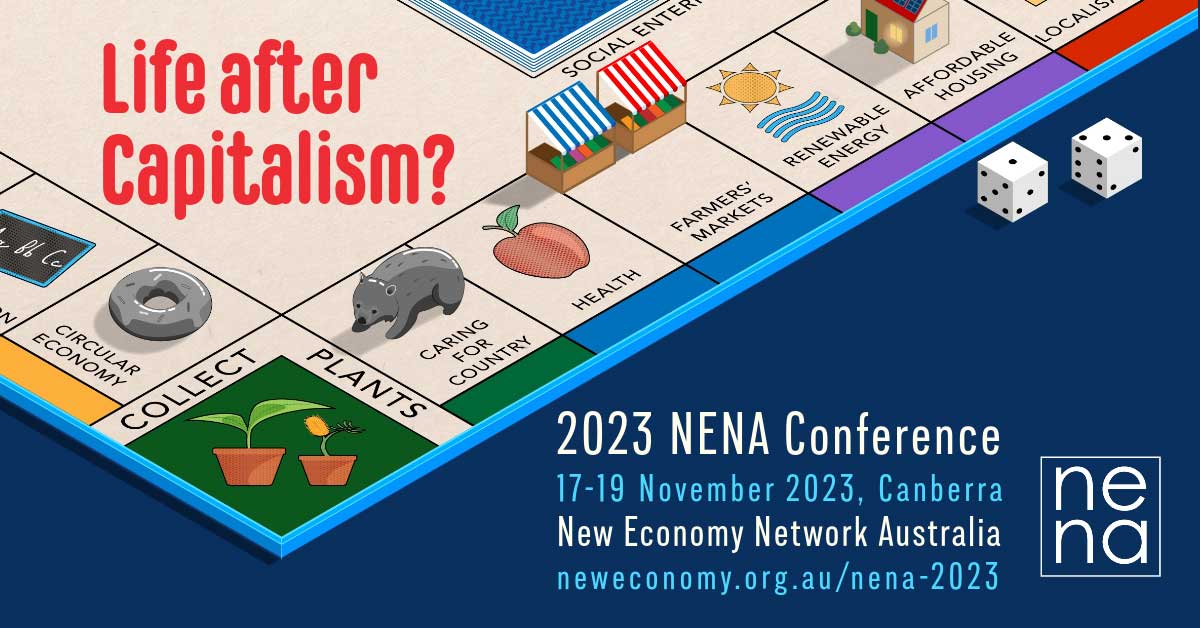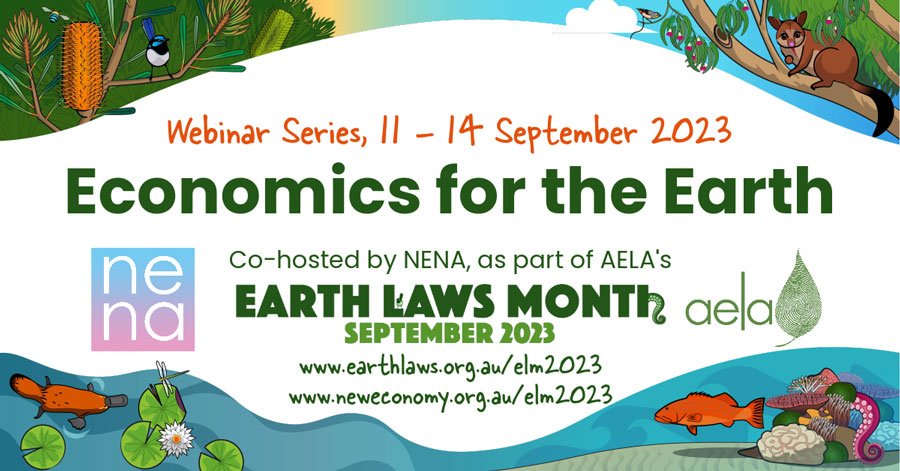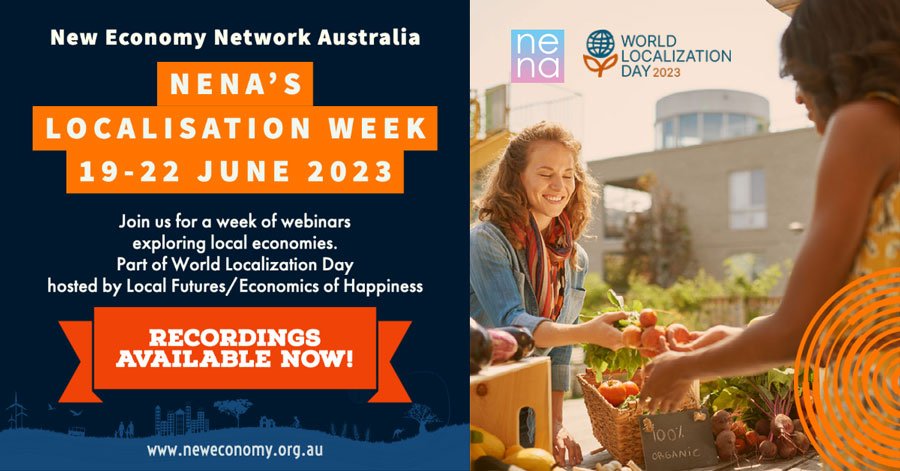Overpopulation is Not the Problem
The New Economy Journal has featured a number of articles this year on the “population problem”: Haydn Washington’s “Denying overpopulation is a double tragedy”; Mark Diesendorf’s “An Environmental Science Perspective on Population”; and Kurt Johnson’s “Scott Morrison’s Population Crisis”. All have expressed grave concern about the environmental effects of overpopulation, Haydn Washington calling it “a key driver of unsustainability”. All say it is unfortunate, given the environmental concern, if population is treated as a “taboo issue”, as they say is being done presently. They denigrate the racist discourse sometimes linked with discussions of population constraint; and argue this link gets in the way of rational discussion of the subject.
In the following I’ll argue that we do not have a problem with overpopulation. Advocates of population constraint often insist misanthropy is not what they intend – that they intend the opposite. But I will show that, nevertheless, a type of misanthropy is a central, unarticulated presumption behind their thinking – or at least behind an equation central to their thinking: the identity I=PAT. I’ll then show that, as Steven Liaros has said, “it's not about how many people, but what the people are doing”. I’ll show that we can live sustainably, despite our numbers – perhaps even because of our numbers. I will finish with a short discussion of what we know about demographic transitions and population growth.
Contents
[1] The "overpopulation" argument
[2] Assumptions behind the "overpopulation" argument
[3] Where did I=PAT come from?
[4] A scientific response, without the misanthropy
[5] We can be gardeners
[6] So what shall we do about population?
[7] An alternative
[8] Conclusion
[1] The "overpopulation" argument
The basic "overpopulation" argument is the following: Human impact on the environment, it is said, can be assessed using a simple linear equation:
I = P * A * T
Where (I) stands for total human impact; (P) stands for population; (A) stands for affluence (i.e. consumption of goods per person); and (T) stands for technology (i.e. the environmental impact of creating and delivering the goods that are consumed).
Taking this equation as a law of nature, they deduce that if we are to live sustainably on this planet we must address all three factors: reduce population, reduce consumption per person, and reduce the energy expended on producing and shipping goods.
Population, due to its place on the right-hand side of the equation, becomes a cause of environmental degradation. This is taken as tautologically true (most obviously in Diesendorf and Washington’s articles). We cannot agree with this: perhaps it is true that population is a cause, as they say, but this would need to be shown by evidence, not by deduction. To surmise this from an equation and deem it tautological is illogical. It is like saying the number two causes the number three to become a six in the equation, 2*3=6. The assumption of tautology, in fact, reveals the misanthropic presumption, which I detail in a moment.
This extraordinary oversimplification of the hugely complex interrelationship between people with each other and with their environment, with their multiple and chaotic feedback loops, is strange. It is also somewhat ironic given the complaint, I think shared by all our overpopulation authors, that mainstream economics has become “weighed down with abstruse mathematical modelling, with little relationship to the real world”.
[2] Assumptions behind the “overpopulation” argument
A common objection to the abstruse mathematics of mainstream economics are the unanalysed assumptions behind their models (all people are assumed to be consumption-maximising hedonists, for example). What are the assumptions behind I=PAT?
The principal assumption is that human beings are necessarily bad for the environment (unless T = 0, in which case humans can be neutral). Is this true? Are humans a necessarily negative planetary force, like a cancer?
First of all, this can’t be true for all natural beings. A tree couldn’t survive without a pre-existing complex ecosystem providing support services. A tree cannot survive on Mars, for example. Life needs other life forms to survive, and so lifeforms are not just takers, but providers. Lifeforms, holistically, have net benefits for other lifeforms. A tree’s existence supports the existence of many other beings, and visa versa; life, in an important sense, is self-reinforcing – a product of mutual relationships producing positive feedback loops allowing life to flourish in increasingly rich forms.
Are human beings different? A species without benefit for any other species? Selfish devourers, never responsible stewards? Is it true, as David Attenborough has said, that “we are a plague on the Earth”? Surely not. If we separate human beings from other life forms, classing them as unnatural or necessarily parasitic, we are in danger of separating the human economy from the natural environment – as our “overpopulation” authors point out mainstream economics does. As they also point out, this is a “fundamental problem”.
If we are to develop a healthy relationship with our environment and other life forms – one which allows us to live sustainably, within ecological limits – we cannot view ourselves as necessarily bad – as pure impact on the left-hand side of the I=PAT equation. We must view ourselves as stewards, living in interdependent relationships, in which our support for ecological flourishing allows us to flourish ourselves. We do not have to be pure impact, like a blow from a hammer; we can be gardeners, working to enrich the world in which we live. We’ll come back to the evidence for this shortly.
I’m tempted to suggest a new equation, which can allow (I) to be a negative value – representing the support services we perform. But I will resist – our ecological thinking ought not to be linear.
[3] Where did I=PAT come from?
The I=PAT equation was developed by environmental scientist Paul Ehrlich and physicist John Holdren. Ehrlich’s book, The Population Bomb, published in 1968, has been particularly influential for “overpopulation” thinkers. Washington notes, for example, that the book “alerted the world to the dangers of exponentially growing population”.
We have observed the implicit misanthropy in the I=PAT identity. Support for this can be found in Ehrlich’s book. Social ecologist (and favoured theorist for the Rojava revolution in northern Syria) Murray Bookchin provides the following account:
The book still reads like a hurricane on the loose, a maddening blowout of spleen and venom. Beginning with a sketch of human misery in Delhi in which “people” (the word is used sneeringly to open almost every sentence on the first page) are seen as “visiting, arguing, and screaming,” as “thrusting their hands through the taxi windows, begging … defecating and urinating,” Ehrlich and family seem to swoon with disgust over “people, people, people, people, people”… Thus it was, we are told, that Ehrlich came to know “the feel of overpopulation,” that is, the sense of disgust that pervades the entire work.”
A few paragraphs later, Bookchin goes on:
The Population Bomb climaxes with a favourable description of what is now known as “the ethics of triage.” Drawn from warfare, as Ehrlich explains, “The idea briefly is this: When casualties crowd a dressing station to the point where all cannot be cared for by the limited medical staff, some decisions must be made on who will be treated. For this purpose the triage system of classification was developed. All incoming casualties are placed in one of three classes. In the first class are those who will die regardless of treatment. In the second are those who will survive regardless of treatment. The third contains those who can be saved only if they are given prompt treatment.”
It is no surprise that this sentiment bred the neo-Malthusian equation, I=PAT.
[4] A scientific response, without the misanthropy
The misanthropy of "overpopulation" thinkers is also seen in their “‘Half Earth’ vision”, where “half the world’s terrestrial surface is protected in conservation reserves”.
This kind of thinking is implicated in not only stark human rights abuses, but also, ironically, in environmental destruction.
The highly impressive advocacy group, Survival International, highlight this. They have an excellent report titled “Parks need peoples: Why evictions of tribal communities from protected areas spell disaster for both people and nature”. They quote a tribal person from India, who says “the jungle is only here because of us”. The report observes that,
Nearly all protected areas such as national parks or game reserves are, or have been, the ancestral homelands of tribal peoples. Today tribal peoples are being illegally evicted from these homelands in the name of “conservation”. The big conservation organizations are guilty of supporting this. They never speak out against evictions. These evictions can destroy both the lives of tribal peoples and the environment they have shaped and cared for over generations.”
“When these guardians of the land are removed,'' the report goes on, “their former environment can also suffer, as poaching, over-harvesting and wildfires increase along with tourism and big business.”
Later, they note that “it is no coincidence that 80% of the world’s biodiversity is found on the lands of tribal peoples and that the vast majority of the 200 most biodiverse places on Earth are tribal peoples’ territories. By developing ways to live sustainably on the land they cherish, tribal peoples have often contributed – sometimes over millennia – towards the high diversity of species around them”.
Indeed, if we look at an important movement – the Rights for Nature movement – it has had its biggest wins when it has advocated for the recognition of Indigenous Peoples’ right to speak for their land. It has been less successful, on the other hand, where the “inherent” right of nature to life has been the focus instead.
The reckless, inhumane, and anti-environmental advocation of a “half earth vision” is another symbol of the inappropriate misanthropy of “overpopulation” thinkers.
[5] We can be gardeners
Let us a look a little closer at Survival International’s claim that people can contribute to high diversity.
The UN Food & Agriculture Organisation recently released a report titled “The State of the World’s Biodiversity for Food and Agriculture”. In it, they discuss Agroecology, which they define as combining “producers’ knowledge, including local and traditional knowledge, with formal scientific knowledge”.
Distinctive features of the science of agroecology include a focus on ecological communities (rather than individual species populations), complex feedback mechanisms, randomness and hysteresis (non-linearity, irreversibility and discontinuity), and emerging properties and interactions rather than simple aggregations.”
In Agroecology, they say, “diversity is regarded as an asset – a source of synergies and risk-spreading and the basis for ecological interactions that sustain essential ecosystem services.”
What this shows, for our purposes, is that a form of farming is possible whereby we are gardeners – we are not pure impact but provide support services for ecosystems and other life forms. But perhaps this vision – of modern society functioning, as tribal peoples do, as nurturers of the environment, is too far fetched given our population levels?
Not at all, says the UN report. 80% of the world’s food, in value terms, is grown on family farms, which account for perhaps only 12% of total agricultural land. At least a third of these farms use agroecological methods. It is not at all farfetched to suggest agroecology could entirely replace our current farming systems – and do so quickly.
Why aren’t we doing this? The reason is that our current food systems are largely based on labour productivity, and not land productivity. This means that even if land productivity is brought way down, so that we need more and more of it to produce the same amount of food, this will be actively encouraged if it means higher labour productivity – i.e. less people involved in production. Charles Eisenstein observes that if “we had 10% of the population engaged in agriculture rather than the current 1%, we could easily feed the country without petrochemicals or pesticides”. Indeed, Eisenstein undersells – we would not just need less fossil fuels, but also need much less land.
As intimated above, we use more than 80% of the world’s agricultural land to produce only 20% of the world’s food in value terms. This is the real driver of ecological destruction – not population growth. Again, from the UN report: “The driver mentioned by the highest number of countries as having negative effects on regulating and supporting ecosystem services is changes in land and water use and management”, which have occurred in the transition to “intensive production of a reduced number of species, breeds and varieties”. In other words, the key driver is the move away from more productive agroecological practices, to much less productive industrial agriculture. This also destroys rural communities, as reduced need for labour shifts people into urban environments. A recent article from The Guardian, ‘How America’s food giants swallowed the family farms’, is an insightful exploration of this trend.
This is all summed up in a critique of environmental vegetarianism provided by journalist Andrea Bergener. She rightly observes, “it’s not so much about what we farm. It’s about how and where”.
Livestock farming on grasslands that require almost no external inputs and regenerate land shouldn’t even be spoken of in the same breath as the beef originating from grain-dependent beef farming: they are chalk-and-cheese scenarios.”
Consistent with this, Bookchin suggests, I think accurately, that much of the correlation between population growth, poverty and environmental degradation “is due to patterns of land ownership”. Let’s look at Australia. In 2016 in Queensland, for example, there was “two-thirds the annual rate of deforestation as in the Brazilian Amazon”, causing huge biodiversity loss. It is not coincidental that The Weekly Times’ 2019 annual report on Who owns Australia’s farms stated, “in a world where scale is king, Australia’s top landholders certainly aren’t holding back in their quest for growth — to the point where the 20 biggest now occupy an area larger than France”. Incidentally, this doesn’t just hold for agricultural property: while Diesendorf, one of our “overpopulation” thinkers, sees immigration as an important cause of unaffordable urban housing, the most important factors are instead property ownership concentration and loose mortgage financing.
[6] So what shall we do about population?
Population needs consideration, but not in the reductive, homogenising way our “overpopulation” authors have done. Population demographics is an important discipline, mapping changes both between generations, and across geographical regions.
Let us look first at intergenerational demography. Haydn Washington suggests that, biologically, we are programmed to produce more and more people: “It is very hard for us to understand in our hearts that now “more” is no longer better”. His answer to the population problem is therefore education – particularly around women’s rights.
While I support this, the state of mind from which this is offered is reminiscent of Malthus, who similarly argued that the only way to avoid “sinking the whole community in misery, is the exercise on the part of the poor of prudence in marriage, and of economy both before and after it”. The impropriety of this approach is shown by the Democratic Republic of the Congo (DRC), which, of countries with more than 1% of the global population, has the highest population growth rate at 3.24%. It is “one of the most dangerous places in the world” – the “rape capital of the world” – a country which has faced significant foreign interference from OECD countries, always to its tremendous detriment. The export of its huge resources has always taken precedence, both for foreign governments and companies and for domestic forces, over the welfare of its people.
There is a clue here that education about female empowerment, like Panadol for the flu, is good, but only a way of alleviating a symptom and not addressing the problem – the problem of poverty and exploitation (incidentally, this means we are no longer talking about the “population problem”).
What we have witnessed – and are witnessing – is a “demographic transition”, called, says Bookchin, quoting Stolnitz (an important demographer), “the most sweeping and best-documented historical trend of modern times”. In this transition, “changes from traditional agrarian economies to modern industrial and urbanized ones involve a change from conditions of high fertility and mortality to conditions of low fertility and mortality”. The population spurts during this transition due to the mix between high fertility and low mortality, before it settles into low fertility and mortality – as it has done in richer countries. The important questions are how to manage the transition so that it is not unnecessarily prolonged and how to secure the living conditions of people making the transition.
What is happening in the DRC is a long prolongation of the transition due to war. The best means for completing the transition is to advocate for OECD countries to cease creating the conditions for war and to act in solidarity with the Congolese people. As documented by Survival International, we are far from that state of affairs even among major NGOs. In letters to the international community written by six villages in the DRC, they “describe horrific violence and abuse by ecoguards funded and supported” by the World Wildlife Fund.
If we do so - that is, stop creating and contributing to the conditions for war - population will level off quickly. If peace and some prosperity can be attained, then, as Bookchin says,
…conditions can stabilize and, given a higher quality of life, yield a relatively stable demographic situation. Entirely new factors emerge that may give rise to negative population growth. I refer not only to a desire for small families and more cultivated lifestyles, and concern for the development of the individual child rather than a large number of siblings, but, above all, women’s liberation movements and the aspirations of young women to be more than reproductive factories.”
This all, of course, has nothing to do with educating out of us an alleged natural impulse to proliferate ourselves.
So that’s intergenerational demographics; what about geographical demographics? This is of most relevance to Australia, given Australia’s population growth is essentially due only to immigration.
The answer is not obvious. It is clear we could not abolish borders tomorrow – there would be wild population flows across regions of the world, likely leading to at least short-term chaos and destruction. In any case, borders are not always bad – I would not suggest the lands or islands of uncontacted tribes in the Amazon and the Pacific should be open to anyone who pleases to go. There are lots of other examples where some kind of border policy would be legitimate. The question is what kind of borders we should have, not whether to have them.
We can learn from the European Schengen agreement: there, as we know, a number of states have agreed to free movement between borders. But what has made this successful, is that the countries are at a similar economic level, and that prospective member-states of the Schengen area are given a helping hand to prepare for their inclusion in the Schengen area by current member-states. This benefits both parties when new states join: there is not a wild population flow from one state to another. This is what we should be working towards – a more equal global economy, allowing us to relax borders as conditions mean the fear of wild flows is assuaged.
In other words, we should be as open as possible as soon as we can; and the greatest extent of openness will be got through international solidarity and development on the developing country’s terms.
[7] An alternative
In an article titled I’m an environmental journalist, but I never write about overpopulation. Here’s why, David Roberts writes that the two best ways of reducing population growth is female empowerment and greater economic equality. He says that focussing on these issues, rather than on overpopulation (which is fraught), is beneficial because they are “a) goals shared by powerful preexisting coalitions, b) replete with ancillary benefits beyond the environmental, and c) unquestionably righteous.”
So why, he asks, focus on overpopulation rather than equality when “the latter gets you all the same advantages with none of the blowback?” Monbiot observes, in agreement, that “there are strong social reasons for helping people to manage their reproduction, but weak environmental reasons, except among wealthier populations.” And wealthier populations, who, as we know, have made the demographic transition, are not evidencing population growth in any case.
[8] Conclusion
Environmental degradation is caused by human behaviour, not population numbers. We can change our behaviour, so that we provide ecosystem support services rather than imposing ecological destruction. As outlined, this is in large part about land use – do we use only a little of it, highly productively, or a lot of it, destructively?
This is the key question for our times. Overpopulation, on the other hand, is not the problem.






















What a buzz, I haven’t read it yet but
It’s great that you are doing this Duncan!
All the best
Peter
No. We are wildly overpopulated. Environments are already failing to sustain us and, even with COVID-19 in full swing, births still outnumber deaths by over 2:1.
If humans were not human and did not behave like humans, then maybe could populate more. However, throughout history human societies have always been inequitable and wasteful. Will fossil fuel companies, banks, arms companies, mining companies and other giant multinationals simply give up their advantages for the sake of the environment, to prevent extinctions? Dream on.
Further, there is absolutely no agreement between cultures as to what needs to be done, even if one group decided to act decisively (which is wildly unlikely in the foreseeable future).
As a result, the natural environment continues to be decimated by human overpopulation – even as advocates as above suggest that we have plenty of room left to completely humanise the Earth. The writer above puts forward ideas that will see the final decimation of large non-human animal species.
It is time to put to bed this dangerous myth that there would be plenty of room for many more billions of the human plague, if only humans did not behave like humans.
Excellent reply. Duncan Wallace failed to provide a solid counter-argument to I = PAT so we can easily ignore the rest of his ramblings. Humans require the destruction of ecosystems, earths life support systems, for their essential needs , especially food, so population numbers are absolutely damaging to biosphere & climate. His argument suggesting ‘we are part of nature’ is exceedingly flimsy & desperate. Hopeless.
Duncan – thanks for a challenging piece. There are parts of your argument I do not find convincing, such as the notion that IPAT is inherently misanthropic and assumes human actions are necessarily ‘bad’. All species affect their environments and at certain population levels can change the nature of their environments, which humans might judge as undesirable (e.g. locust irruptions). Most of us would agreethat humans are currently impacting our planet in undesirable ways.
Of course, IPAT is a simplification. The global human system is highly complex. As a mathematician, I would prefer to reformulate I = f(P,A,T). I would suggest however, that human impacts generally go up, but rarely if stay level, let alone decrease, as population increases, everything else being equal
Your critique of the half-earth idea is off-target. I assume here you are talking about EO Wilson’s proposal, not the ecomodernist’s scheme. It has to be placed in the context of the ever-expansion of global capitalism into ‘natural areas’ and their consequent destruction. It does not at all mean that indigenous groups should be excluded; indeed, it can complement arguments for protecting their lands and honouring their custodianship,
Your point about food production poses some important questions. Industrial agriculture is indeed highly destructive. I am sure changing the way we grow food could radically reduce impacts; I do not know whether our current population can be fed in a truly sustainable way using your proposed approach.
If your argument is that our current global population can live in a way that maintains key environmental indicators at safe level, you would need to describe more thoroughly the society and economy you envisage, because food production is only one component of the human economy. What would infrastructure and transport systems look like? What about the range of other areas of personal material consumption? Most importantly, what would our energy production systems look like, as this has completely underpinned the huge increase in resource consumption over the last 250 years. Even in food production, what would be the capital and other resource inputs?
Even if, your economy model was theoretically completely environmentally benign, I=f(P,A,T) would still apply, as you say, because T would equal zero.
I avoid the use of the term ‘overpopulation’ for a number of reasons, but I do argue that population is a factor in environmental impacts, everything else being equal. Whatever the form of society and economy you envisage, there are resource and energy requirements, and wastes created. Even if your society model were ‘sustainable’ at current population levels, it is obvious that at a certain higher population level, our finite planet could not support it. Similarly, living ‘sustainably’ would be much easily achieved if our global population were much smaller, particularly in high consumption countries.
Thanks for your comment! I address some of your points in the following article, ‘An Empirical Objection to IPAT: A Reply to Mark Diesendorf’:
https://www.neweconomy.org.au/journal/issues/vol2/iss3/an-empirical-objection-to-ipat/?fbclid=IwAR3HMXfDKgnau7qClS-sPnG-1vAypssynZq3zoIT96ZsDe-MGLzZajwdGok
I agree Duncan, there is no overpopulation in this vast universe, only inappropriate behaviour. People need Ahimsa Laws to thrive. Ahimsa (non-violence) is an old Eastern notion of how to be in harmony with nature. It may need adaption to our times, but the gist is that consciousness needs guidelines and building. Genetics shows all people are related, mammals are kin. We have a choice, remain a few selfish feuding Apex Predators, or become many in a multicultural meritocracy. Various habits have been banned to build viable community, like duels, marrying family, theft, drunk driving. It needs Ahimsa Laws to guide behaviour. Australia can become a model. Habits were formed when people were few, nature plenty. But habitat is fouled, jails are full, conflicts rage. With 8 billion the roles are reversed. Time for new rules.
The human adventure may have barely started